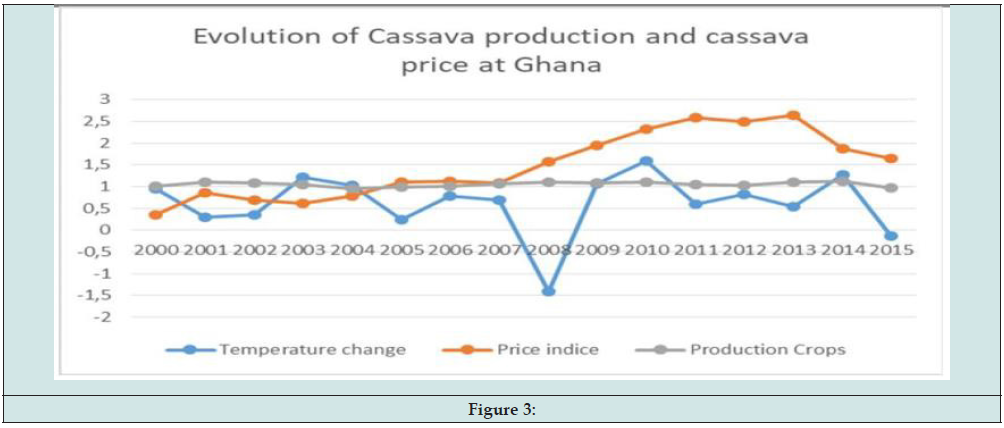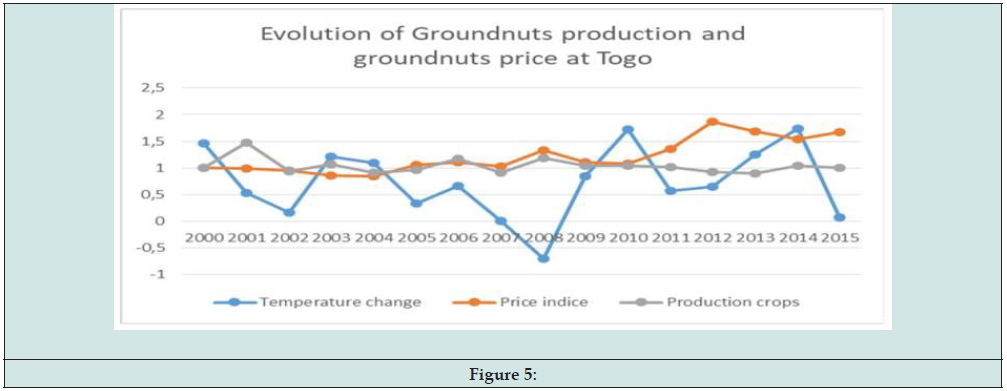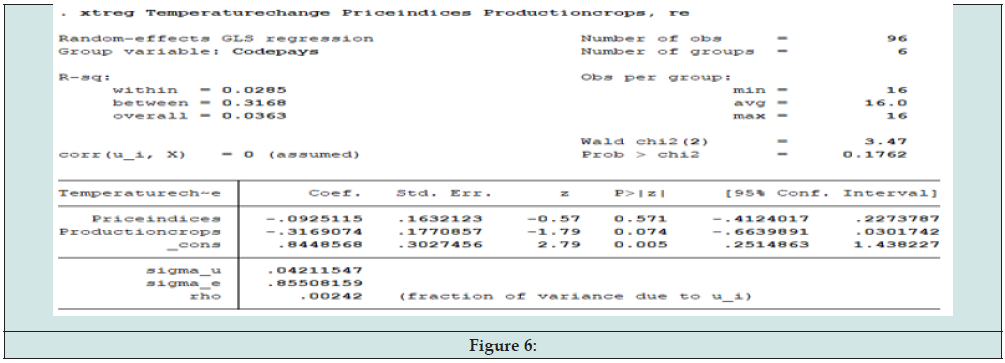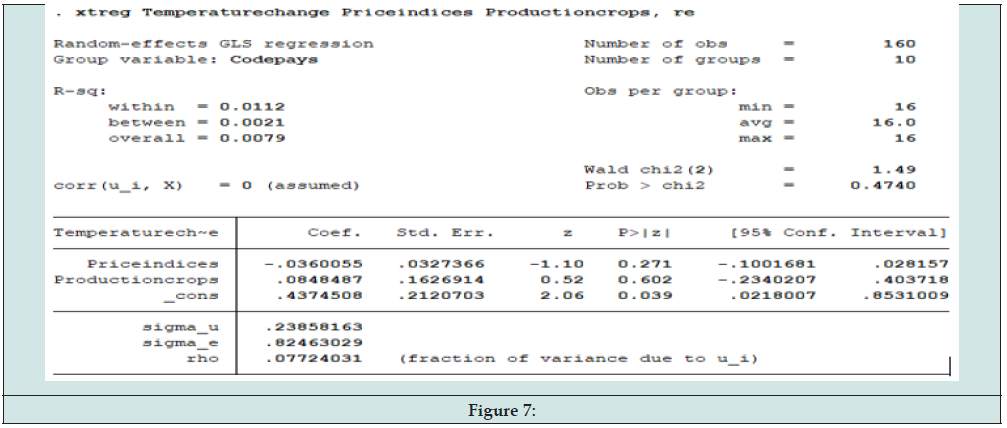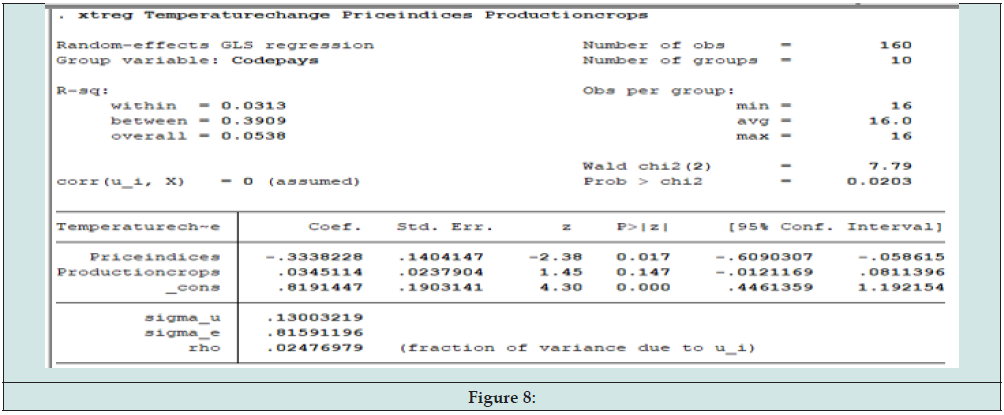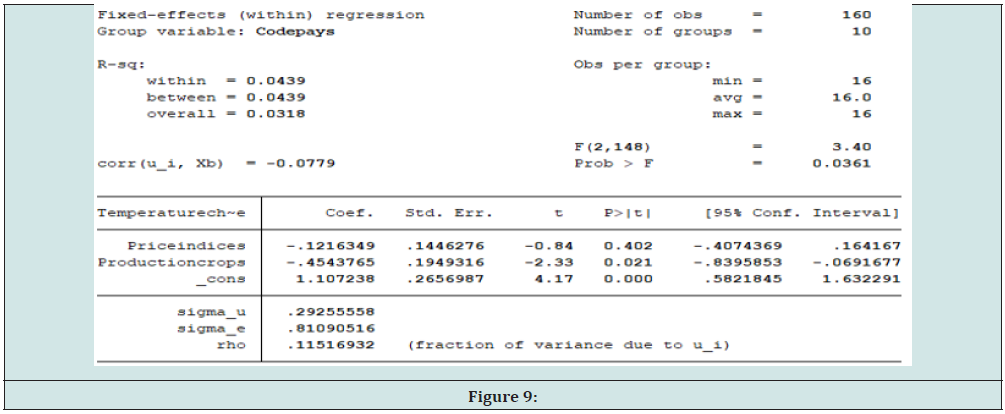
Lupine Publishers Group
Lupine Publishers
Menu
ISSN: 2637-4676
Research Article(ISSN: 2637-4676) 
Impact of Climate Change on Food Production and Food Prices in West Africa Volume 10 - Issue 1
Bebga Nguidjoi Thomas Gael*
- Statistician and PhD Researcher, Department of Economics, University of Dschang, Cameroon
Received: August 03, 2022; Published: August 16, 2022
Corresponding author: Bebga Nguidjoi Thomas Gael, Statistician and PhD researcher in Economics, University of Dschang, Yaounde Cameroon
DOI: 10.32474/CIACR.2022.10.000330
Abstract
West Africa is a semiarid region with a rapidly growing population and a very low gross domestic product. Climate change poses a major and growing threat to global food security. In many regions, agricultural production is already being adversely affected by rising temperatures, increased temperature variability, changes in levels and frequency of precipitation. This paper seeks to discuss the main issues in climate change discourse emphasising on how they implicate agriculture and food security in West Africa. Overall, the panel data econometric model indicate that for rice and groundnuts the change in temperature has a negative influence on their respective levels of production. For maize the change of temperature has an influence on the level of the prices. Furthermore, for yams and cassava, the change in temperature has no influence on production and prices.
Keywords: Climate Change; Food prices; Food production; Econometric Model; Panel Data
Introduction
West Africa is a semiarid region with a rapidly growing population and a very low gross domestic product1. Like in many regions around the world, West African markets have recently become more integrated with each other- and with the global commodity markets. Intergovernmental Panel on Climate Change (IPCC) 2007 report estimated that warming global temperatures are likely to reduce West African agricultural production by up to 50 percent by the year 2020 [1]. The impact of climate change on rainfall is far less certain, particularly because global climate models often have difficulty reproducing West Africa’s complex monsoonal rainfall which is dominated by waves of moisture moving east across the continent [2]. Climate change 2 poses a major and growing threat to global food security [3]. The expected effects of climate change – higher temperatures, more frequent extreme weather events, water shortages, rising sea levels, ocean acidification, land degradation, the disruption of ecosystems and the loss of biodiversity – could seriously damage agriculture’s ability to feed the most vulnerable, impeding progress towards the eradication of hunger, malnutrition and poverty. In many regions, agricultural production is already being adversely affected by rising temperatures, increased temperature variability, changes in levels and frequency of precipitation, a greater frequency of dry spells and droughts, the increasing intensity of extreme weather events, rising sea levels, and the salinization of arable land and freshwater. As climate change impacts on agriculture intensify, it will become increasingly difficult to grow crops, raise animals, manage forests and catch fish in the same ways and in the same places as we have done in the past. This state of affairs has led us to the following question: what is the impact of climate change on food production and food prices in West Africa ? This paper seeks to discuss the main issues in climate change discourse emphasising on how they implicate agriculture and food security in West Africa.
a) Abdulai A, et al. [5] Determinants of income diversification amongst rural.
b) The State of Food and Agriculture Climate Change, Agriculture and Food Security [6].
The objective of this work is twofold and will consist of exposing impact of climate change, the situation of food production and food prices in West Africa and analyze by an econometric model the impact of climate change on production and prices. The first part is devoted to the impact of climate change on production. The second part is intended to analyse the situation of food production and food prices in West Africa. The third part will present the econometric model of impact of climate change on food production and food prices.
LEFT I: Climate Change and Its Impact
Climate change happens in different ways, ranging from increased climate variability and gradual changes in temperature and precipitation, to increased frequency and intensity of extreme events.
Climate and its measurement
Climate refers to the characteristic conditions of the earth’s lower surface atmosphere at a specific location; weather refers to the day-to-day fluctuations in these conditions at the same location. The variables that are commonly used by meteorologists to measure daily weather phenomena are air temperature, precipitation (e.g. rain, sleet, snow and hail), atmospheric pressure and humidity, wind, and sunshine and cloud cover.
Effects of global warming on the climate system
Global warming is the immediate consequence of increased greenhouse gas emissions with no offsetting increases in carbon storage on earth. This paper is concerned mainly with the projected effects of the current episode of human-induced global warming on the climate system, now and for the next several decades, as these are the effects that will both cause additional stresses and create new opportunities for food systems, with consequent implications for food security. In summary:
a. Climate change has significant implications for agriculture and food security, creating new risks and challenges and exacerbating existing vulnerabilities from the local to the global level.
b. Rural livelihood systems and poor or marginalized groups that mainly depend on agriculture, forestry, fishery sectors, are the most vulnerable and strongly affected by climate change.
c. Climate change can affect all dimensions of the food security of vulnerable groups as well as different elements of food systems.
d. Climate change and food security are twin challenges which need to be addressed together.
LEFT II: Situation of Food Production and Food Prices in West Africa
In this section, we will present the evolution of food production, food price and temperature change in West Africa. We used production crops indices and price indices. Data come from FAO statistics from 2000 to 2015. We considered countries of West Africa (Figure 1). This graph shows that the temperature changes are negative in Nigeria with severe peaks in 2007 and 2008. Yams production in Nigeria varied significantly between 2007 and 2011. The price index fell sharply between 2008 and 2009 (Figure 2). Temperatures varied significantly from 2007 to 2015 with a peak in 2009. Also between 2008 and 2011, Maize production experienced a fall due also to the decrease in the level of temperatures. The price index showed a mixed trend from 2000 to 2015 (Figure 3). Temperatures varied from 2000 to 2015 with a negative peak in 2008. Production was mixed and cassava prices changed from 2000 to 2013 (Figure 4). Temperature variations are significant in Mali with negative peaks in 2008 and 2009. There were mixed developments in rice production and the price index (Figure 5). Temperature variations are significant in Togo with a negative peak in 2008. Groundnuts production and the price index were mixed from 2004 to 2010.
LEFT III: Econometric Analysis
Data analysis
In this section we performed an econometric panel data analysis using STATA software. The variables used for this analysis are respectively temperature changes, food prices indices, and gross production indices in the countries that constitute our field of study. We considered the most common foods in West Africa indispensable in their diet: Yams, Cassava, Rice, Maize and Groundnuts (www.ricediversity.org).
Econometric analysis
As an explanatory variable, we have food prices indices, and production crops indices. The dependant variable is temperature changes. The data sources come from statistics of FAO (FAOSTAT). The current variables move from 2000 to 2015.
Presentation of the econometric model
We have five panel data econometric for the most common food in West Africa (Yams, Cassava, Rice, Maize and Groundnuts). In order to determine the type of model, we will use the Breusch- Pagan test to determine whether it is a fixed-effect model or a random-effect model.
In the case of a fixed effects model:

In the case of a random effects model:

Where :
Yit: Temperature change
X1: Food Price indice
X2: Food Production crops indice; it ε and i α : are unrelated random disturbances.
Estimating model parameters, validating assumptions and interpreting results
We have estimated models and the results are recorded in the following table:
a) Yams econometric model
The Breusch Pagan test gives: chibar2(01) = 0.02 and Prob > chibar2 = 0.4452 We accept the hypothesis of random effects (Figure 6). For the yams model the change in temperature has no influence on the price index and production at the 5% threshold.
Cassava econometric model
The Breusch Pagan test gives: chibar2(01) =2.18 and Prob > chibar2 = 0.0700 We accept the hypothesis of random effects (Figure 7). For the cassava model, the change in temperature has no influence on the price index and production at the 5% threshold.
Maize econometric model
The Breusch Pagan test gives: chibar2(01) =0.26 and Prob > chibar2 = 0.3036 We accept the hypothesis of random effects (Figure 8). The Maize model is very significant at the 5% threshold, and it appears that the change in temperature has a negative influence on the price index.
Rice econometric model
The Breusch Pagan test gives: chibar2(01) =3.17 and Prob > chibar2 = 0.0375 We accept the hypothesis of fixed effects (Figure 9). The rice model is very significant at the 5% threshold and the change in temperature has negative influence on rice production.
Groundnuts econometric model
The Breusch Pagan test gives: chibar2(01) =0.36 and Prob > chibar2 = 0.2735 We accept the hypothesis of random effects (Figure 10). The groundnuts model is very significant, and it follows that the change in temperature has a negative influence on the level of groundnuts production at the 5% threshold.
Conclusion
The main objective of the study was to understand how temperature changes could influence the food production and food price in West Africa. Three main points were addressed to explain this concern. First, an overview of climate change an its impact. Second we present the situation of food production and food price in West Africa. Third we carried out an econometric analysis on panel data. Overall, the results indicate that for rice and groundnuts the change in temperature has a negative influence on their respective levels of production. For the maize the change of temperature has an influence on the level of the prices. Furthermore, for yams and cassava, the change in temperature has no influence on production and prices.
References
- IPCC (2007) IPCC Fourth Assessment Report. Rome, Italy, Intergovernmental Panel on Climate Change.
- Cook K, Vizy EK (2006) Coupled Model Simulations of the West African Monsoon System: 20th and 21st Century Simulations. Journal of Climate 19(15): 3681-3703.
- FAO (2006) The State of Food and Agriculture Climate Change.
- Abdulai A, Crolerees A (2001) Determinants of income diversification amongst rural. Food Policy 26(4): 437-452.
- FAO (2018) Africa Addressing the Threat from Climate Variability and Extremes for food security and nutrition (Food and Agriculture Organization of the United Nations).

Top Editors
-

Mark E Smith
Bio chemistry
University of Texas Medical Branch, USA -

Lawrence A Presley
Department of Criminal Justice
Liberty University, USA -

Thomas W Miller
Department of Psychiatry
University of Kentucky, USA -

Gjumrakch Aliev
Department of Medicine
Gally International Biomedical Research & Consulting LLC, USA -

Christopher Bryant
Department of Urbanisation and Agricultural
Montreal university, USA -

Robert William Frare
Oral & Maxillofacial Pathology
New York University, USA -

Rudolph Modesto Navari
Gastroenterology and Hepatology
University of Alabama, UK -

Andrew Hague
Department of Medicine
Universities of Bradford, UK -

George Gregory Buttigieg
Maltese College of Obstetrics and Gynaecology, Europe -

Chen-Hsiung Yeh
Oncology
Circulogene Theranostics, England -
.png)
Emilio Bucio-Carrillo
Radiation Chemistry
National University of Mexico, USA -
.jpg)
Casey J Grenier
Analytical Chemistry
Wentworth Institute of Technology, USA -
Hany Atalah
Minimally Invasive Surgery
Mercer University school of Medicine, USA -

Abu-Hussein Muhamad
Pediatric Dentistry
University of Athens , Greece

The annual scholar awards from Lupine Publishers honor a selected number Read More...






